engine overheat GMC SIERRA 1995 Owners Manual
[x] Cancel search | Manufacturer: GMC, Model Year: 1995, Model line: SIERRA, Model: GMC SIERRA 1995Pages: 488, PDF Size: 26.01 MB
Page 7 of 488
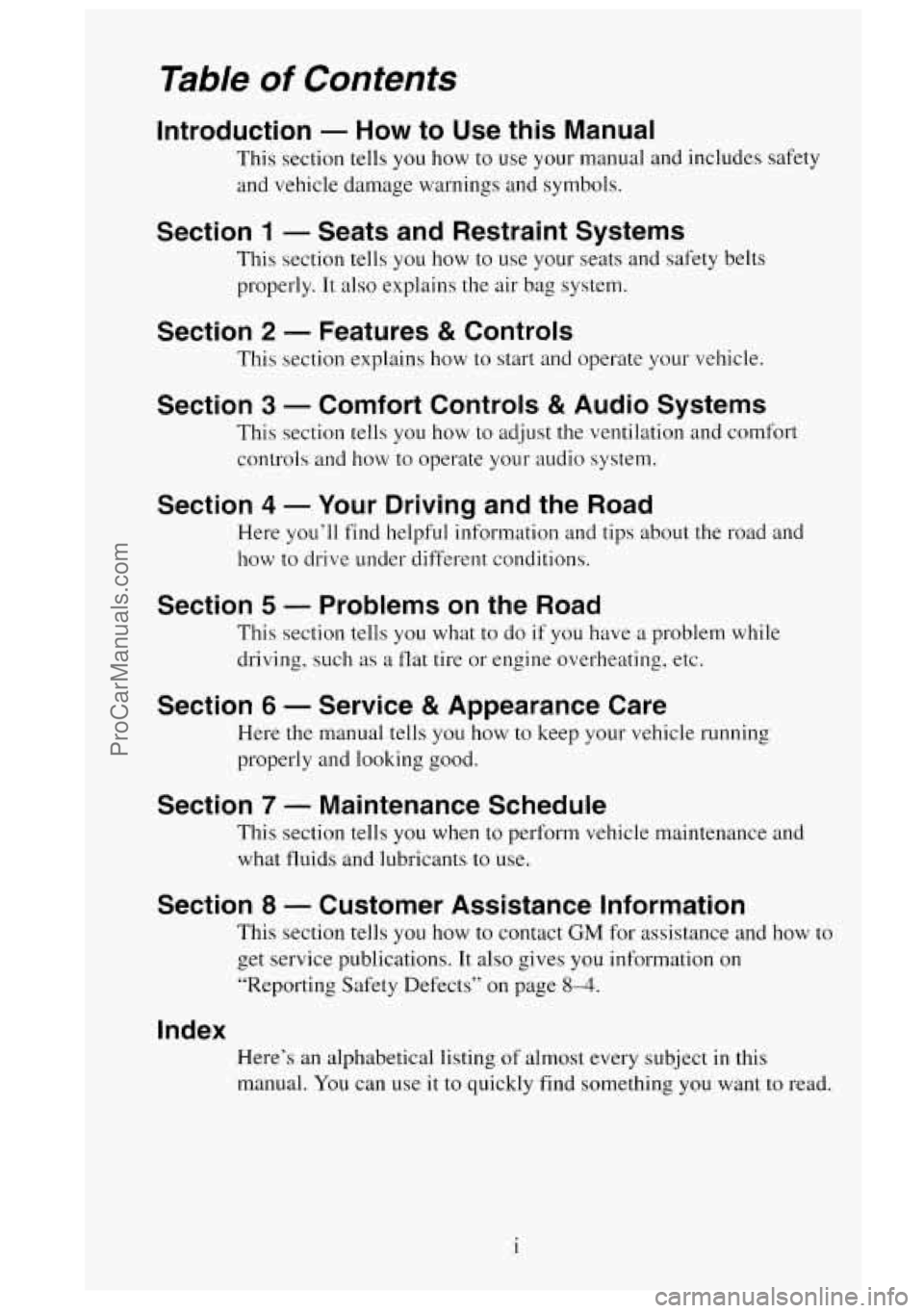
Table of Contents
Introduction - How to Use this Manual
This section tells you how to use your manual and includes safety
and vehicle damage warnings and symbols.
Section 1 - Seats and Restraint Systems
This section tells you how to use your seats and safety belts
properly.
It also explains the air ba, 0 s -y stem.
Section 2 - Features & Controls
This section explains how to start and operate your vehicle.
Section 3 - Comfort Controls & Audio Systems
This section tells you how to adjust the ventilation and comfort
controls and how to operate your audio system.
Section 4 - Your Driving and the Road
Here you’ll find helpful information and tips about the road and
how to drive under different conditions.
Section 5 - Problems on the Road
This section tells you what to do if you have a problem while
driving, such
as a flat tire or engine overheating. etc.
Section 6 - Service & Appearance Care
Here the manual tells you how to keep your vehicle running
properly and looking good.
Section 7 - Maintenance Schedule
This section tells you when to perform vehicle maintenance and
what fluids and lubricants to use.
Section 8 - Customer Assistance Information
L get service publications. It also gives you information on
This
section tells you how to contact
GM for assistance and how to
“Reporting Safety Defects” on page
8-4.
Index
Here’s an alphabetical listing of almost every subject in this
manual. You can use
it to quickly find something you want to read.
i
ProCarManuals.com
Page 78 of 488
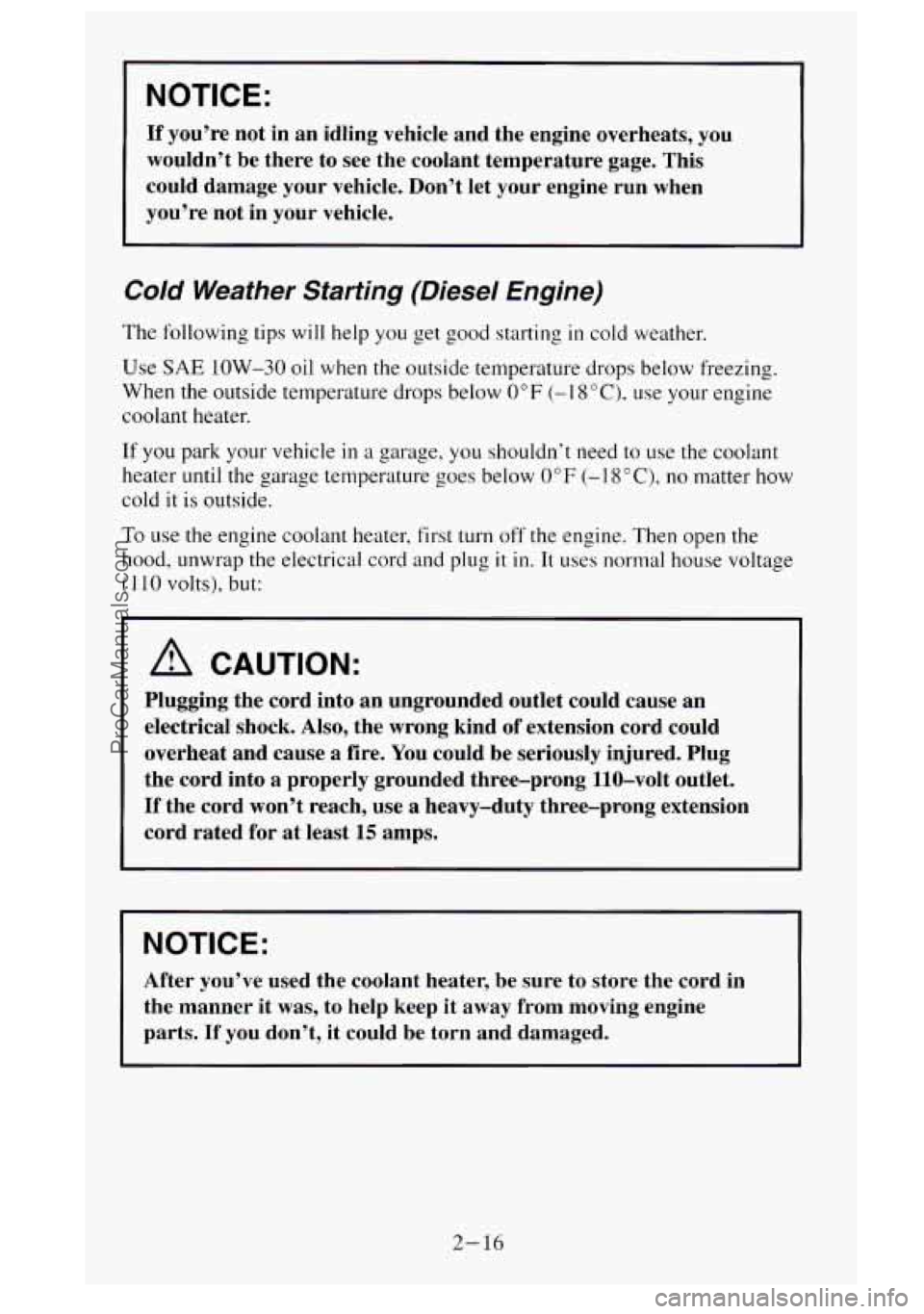
NOTICE:
If you’re not in an idling vehicle and the engine overheats, you
wouldn’t be there to see the coolant temperature gage. This
could damage your vehicle. Don’t let your engine run when
you’re not in your vehicle.
Cold Weather Starting (Diesel Engine)
The following tips will help you get good starting in cold weather.
Use
SAE IOW-30 oil when the outside temperature drops below freezing.
When the outside temperature drops below
0°F (-1 floc), use your engine
coolant heater.
If you park your vehicle in a garage, you shouldn’t need to use the coolant
heater until the garage temperature goes below
0°F (-I SOC), no matter how
cold
it is outside.
To use the engine coolant heater, first turn off the engine. Then open the
hood, unwrap the electrical cord and plug it in. It uses normal house voltage
(I 10 volts), but:
A CAUTION:
Plugging the cord into an ungrounded outlet could cause an
electrical shock. Also, the wrong kind of extension cord could
overheat and cause
a fire. You could be seriously injured. Plug
the cord into a properly grounded three-prong 110-volt outlet.
If the cord won’t reach, use a heavy-duty three-prong extension
cord rated for
at least 15 amps.
NOTICE:
After you’ve used the coolant heater, be sure to store the cord in
the manner it was, to help keep it away from moving engine
parts.
If you don’t, it could be torn and damaged.
2-16
ProCarManuals.com
Page 80 of 488
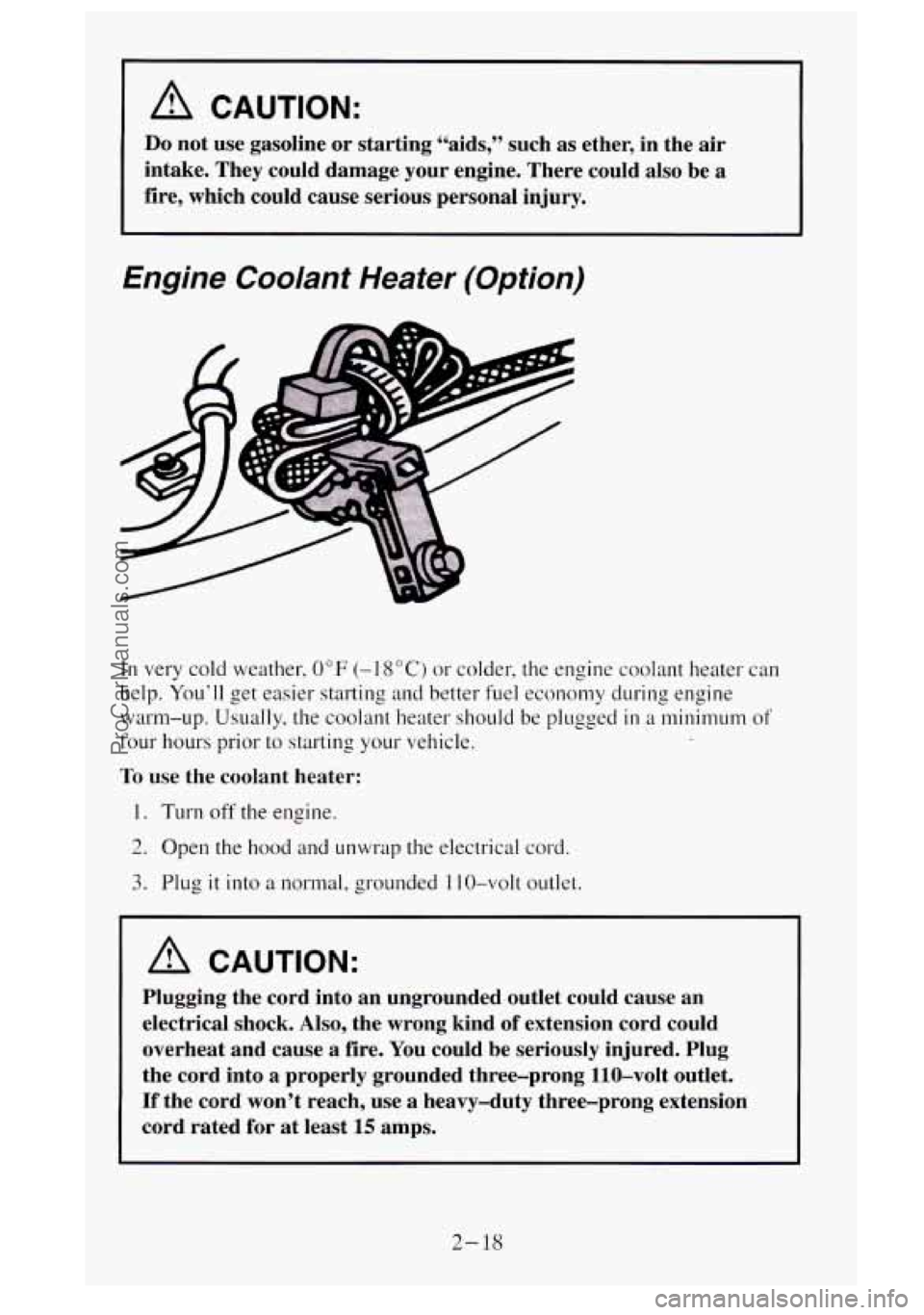
A CAUTION:
Do not use gasoline or starting “aids,” such as ether, in the air
intake. They could damage your engine. There could also be
a
fire, which could cause serious personal injury.
Engine Coolant Heater (Option)
In very cold weather. 0°F (-I SOC) or colder, the engine coolant heater can
help. You’ll get easier starting and better fuel economy during engine
warm-up. Usually, the coolant heater should
be plugged in a minimum of
four hours prior to starting your vehicle.
To use the coolant heater:
1. Turn off the engine.
2. Open the hood and unwrap the electrical cord.
3. Plug it into a normal, grounded I IO-volt outlet.
A CAUTION:
Plugging the cord into an ungrounded outlet could cause an
electrical shock. Also, the wrong kind
of extension cord could
overheat and cause
a fire. You could be seriously injured. Plug
the cord into
a properly grounded three-prong 110-volt outlet.
If the cord won’t reach, use a heavy-duty three-prong extension
cord rated for
at least 15 amps.
2-18
ProCarManuals.com
Page 92 of 488
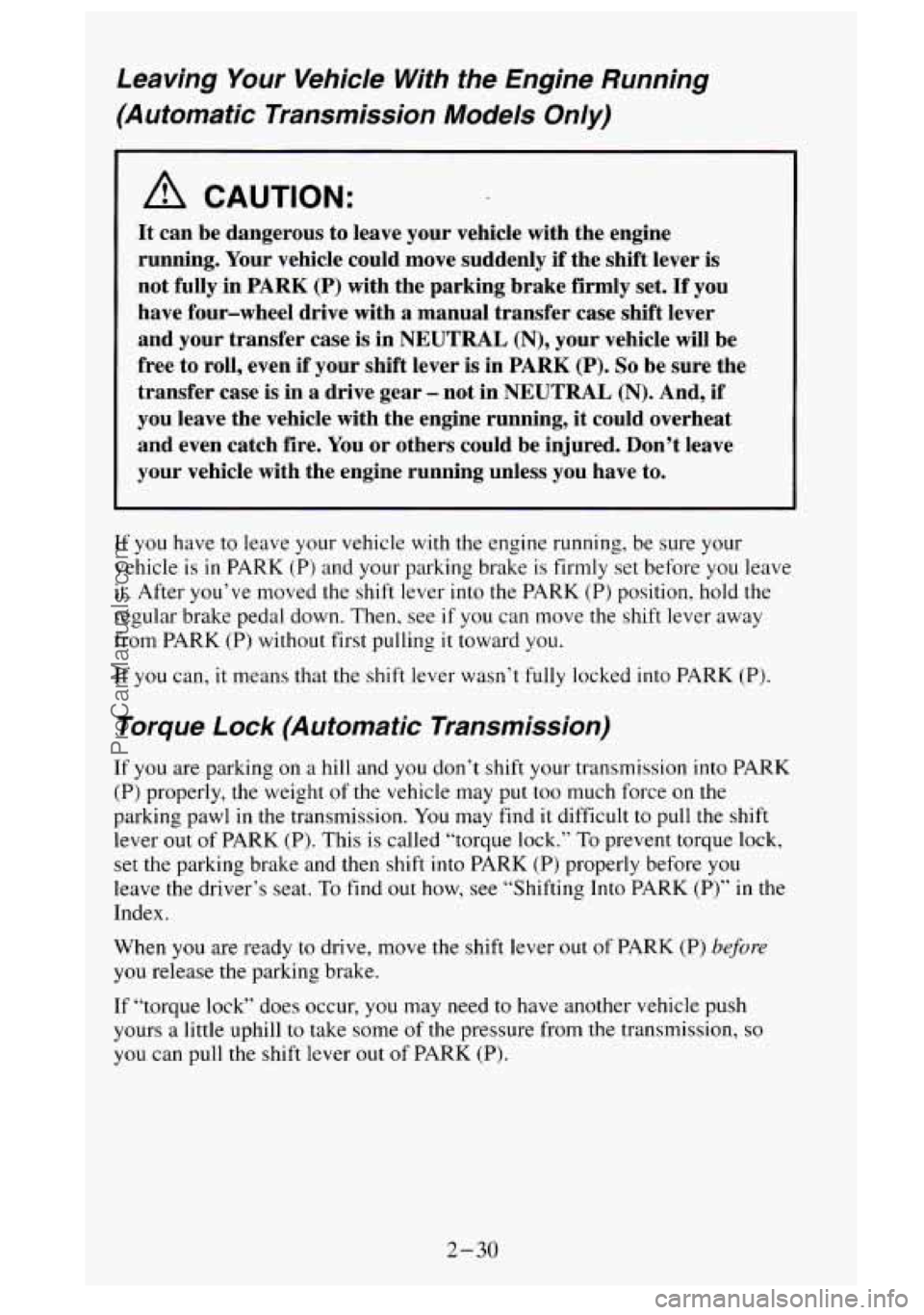
Leaving Your Vehicle With the Engine Running
(Automatic Transmission Models
Only)
A CAUTION:
It can be dangerous to leave your vehicle with the engine
running. Your vehicle could move suddenly if the shift lever
is
not fully in PARK (P) with the parking brake firmly set. If you
have four-wheel drive with a manual transfer case shift lever
and your transfer case is in
NEUTRAL (N), your vehicle will be
free to roll, even if your shift lever is in PARK
(P). So be sure the
transfer case
is in a drive gear - not in NEUTRAL (N). And, if
you leave the vehicle with the engine running, it could overheat
and even catch fire.
You or others could be injured. Don’t leave
your vehicle with the engine running unless you have to.
If you have to leave your vehicle with the engine running, be sure your
vehicle is in PARK (P) and your parking brake is firmly set before you leave
it. After you’ve moved the shift lever into the PARK (P) position, hold the
regular brake pedal down. Then. see
if you can move the shift lever away
from PARK (P) without first pulling
it toward you.
If
you can, it means that the shift lever wasn’t fully locked into PARK (P).
Torque Lock (Automatic Transmission)
If you are parking on a hill and you don’t shift your transmission into PARK
(P) properly, the weight of the vehicle may put too much force on the
parking pawl in the transmission.
You may find it difficult to pull the shift
lever out of PARK (P). This is called “torque lock.” To prevent torque lock,
set the parking brake and then shift into PARK (P) properly before you
leave the driver’s seat.
To find out how, see “Shifting Into PARK (P)” in the
Index.
When you are ready to drive, move the shift lever out
of PARK (P) before
you release the parking brake.
If “torque lock” does occur, you may need to have another vehicle push
yours
a little uphill to take some of the pressure from the transmission, so
you can pull the shift lever out of PARK (P).
2-30
ProCarManuals.com
Page 142 of 488
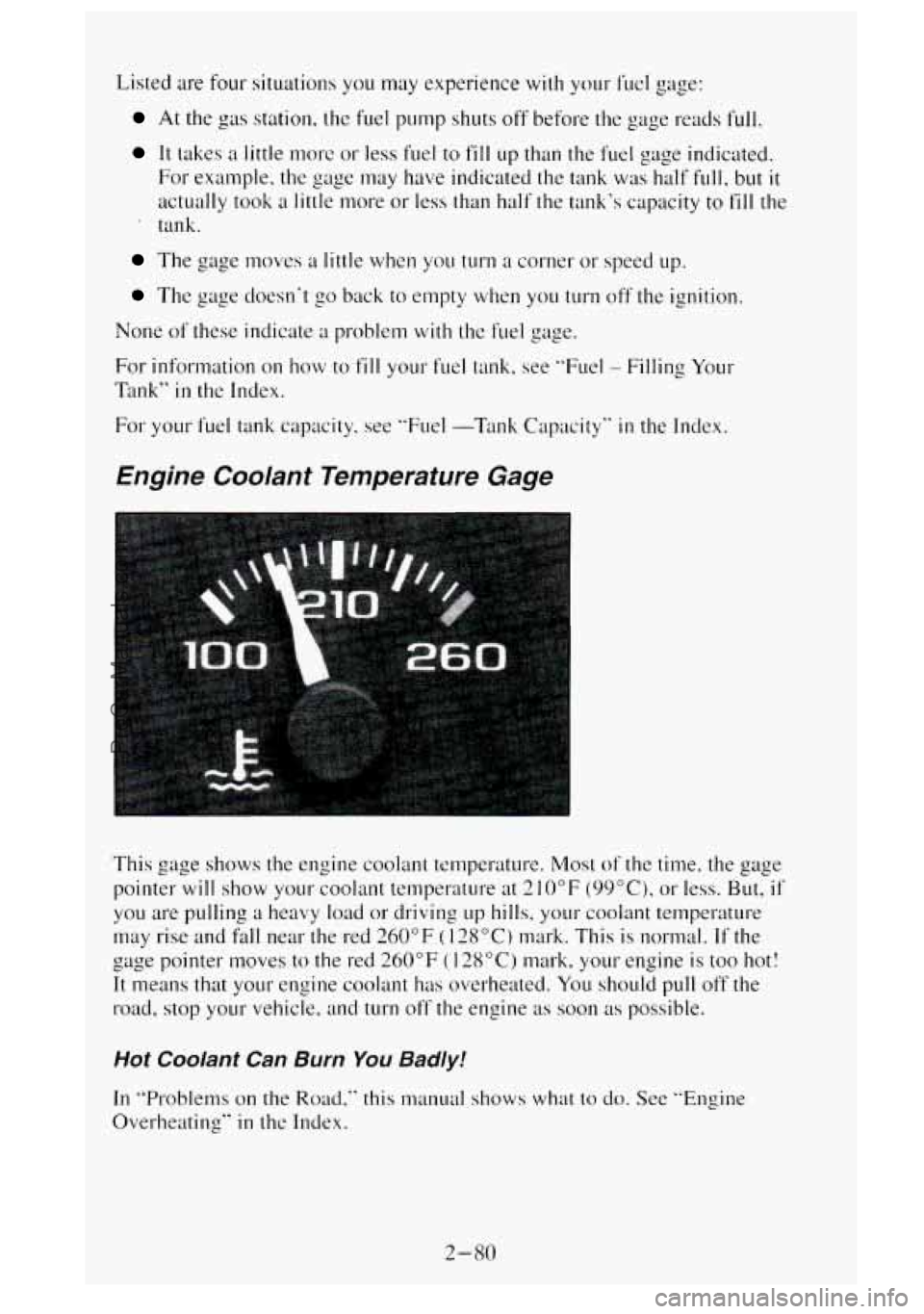
Listed are four situations you may experience with your f~~el gage:
At the gas station. the fuel pump shuts off before the gage reads full.
It lakes a little more or less fuel to fill up than the fuel gage indicated.
For example, the gage may have indicated the tank was half
full, but it
actually took a little more or less than half the tank's capacity to fill the
, tank.
The gage moves a little when you turn a corner or speed up.
The gage doesn't go back to empty when you turn off the ignition.
None of these indicate
a problem with the fuel gage.
For information on how to fill your fuel tank, see "Fuel - Filling Your
Tank"
in the Index.
For your fuel tank capacity, see "Fuel -Tank Capacity" in the Index.
Engine Coolant Temperature Gage
This gage shows the engine coolant temperature. Most of the time. the gage
pointer
will show your coolant temperature at 2 10°F (99"C), or less. But, if
you are pulling a heavy load or driving LIP hills, your coolant temperature
may rise and
fall near the red 260°F ( 128°C) mark. This is normal. If the
gage pointer moves to the red 260°F
(128°C) mark, your engine is too hot!
It means that your engine coolant has overheated. You should pull off the
road,
stop your vehicle. and turn off the engine as soon as possible.
Hot Coolant Can Burn You Badly!
In "Problems on the Road," this manual shows what to do. See "Engine
Overheating"
in thc Index.
2-80
ProCarManuals.com
Page 193 of 488
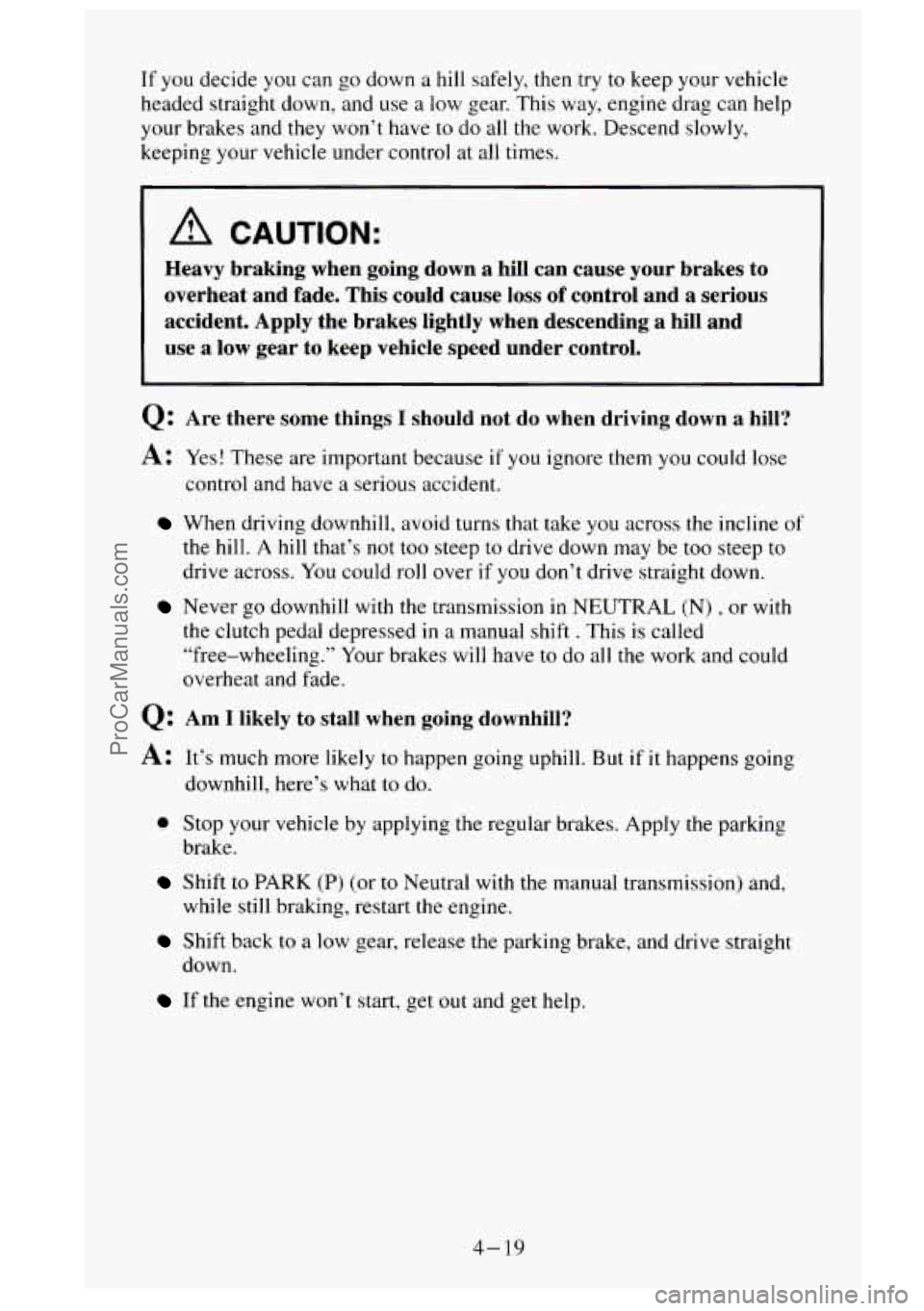
If you decide you can go down a hill safely, then try to keep your vehicle
headed straight down, and use a low gear. This way, engine drag can help
your brakes and they won’t have to do all
the work. Descend slowly,
keeping your vehicle under control at all times.
A CAUTION:
Heavy braking when going down a hill can cause your brakes to
overheat and fade. This could cause
loss of control and a serious
accident. Apply the brakes lightly when descending
a hill and
use a low gear to keep vehicle speed under control.
Q: Are there some things I should not do when driving down a hill?
A: Yes! These are important because if you ignore them you could lose
control and have a serious accident.
When driving downhill, avoid turns that take you across the incline of
the hill. A hill that’s not too steep to drive down may be too steep to
drive across.
You could roll over if you don’t drive straight down.
Never go downhill with the transmission in NEUTRAL (N) , or with
the clutch pedal depressed in a manual shift
. This is called
“free-wheeling.” Your brakes will have to do all the work and could
overheat and fade.
Q: Am I likely to stall when going downhill?
A: It’s much more likely to happen going uphill. But if it happens going
downhill, here’s what
to do.
0 Stop your vehicle by applying the regular brakes. Apply the parking
brake.
Shift to PARK (P) (or to Neutral with the manual transmission) and,
while still braking, restart the engine.
down.
Shift back to a low gear, release the parking brake, and drive straight
If the engine won’t start, get out and get help.
4- 19
ProCarManuals.com
Page 221 of 488
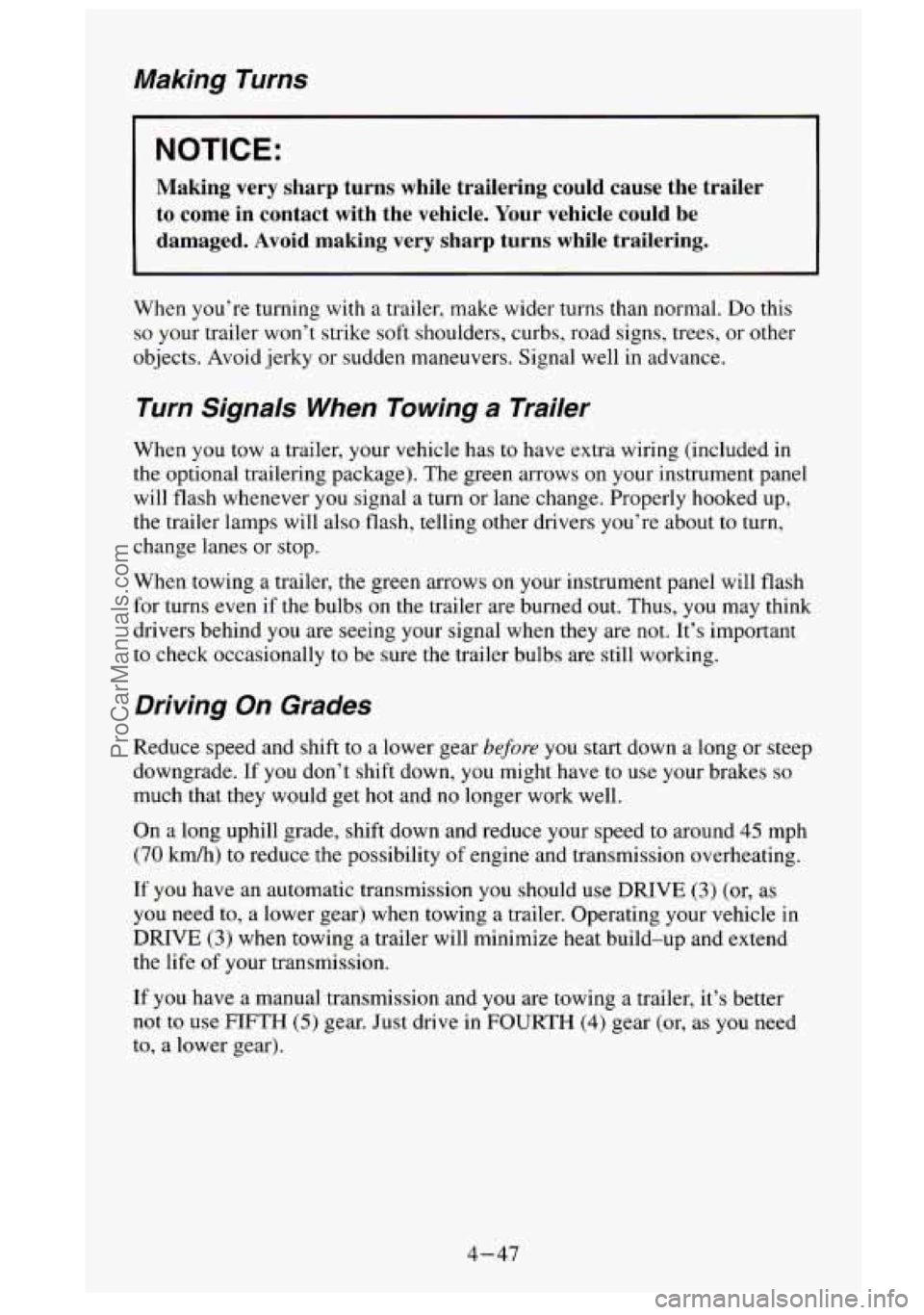
Making Turns
I NOTICE:
Making very sharp turns while trailering could cause the traile\
r to come in contact with the vehicle. Your vehicle could be
damaged. Avoid making very sharp turns while trailering.
When you’re turning with a trailer, make wider turns than normal. Do this
so your trailer won’t strike soft shoulders, curbs, road signs, trees, or other
objects. Avoid jerky or sudden maneuvers. Signal well in advance.
Turn Signals When Towing a Trailer
When you tow a trailer, your vehicle has to have extra wiring (included in
the optional trailering package). The green arrows
on your instrument panel
will flash whenever
you signal a turn or lane change. Properly hooked up,
the trailer lamps will also flash, telling other drivers you’re about to turn,
change lanes or stop.
When towing a trailer, the green arrows on your instrument panel will flash
for
turns even if the bulbs on the trailer are burned out. Thus, you may think
drivers behind
you are seeing your signal when they are not. It’s important
to check occasionally to be sure the trailer bulbs are still working.
Driving On Grades
Reduce speed and shift to a lower gear before you start down a long or steep
downgrade. If
you don’t shift down, you might have to use your brakes so
much that they would get hot and no longer work well.
On
a long uphill grade, shift down and reduce your speed to around 45 mph
(70 kmh) to reduce the possibility of engine and transmission overheating.
If you have an automatic transmission
you should use DRIVE (3) (or, as
you need to, a lower gear) when towing a trailer. Operating your vehicle in
DRIVE (3) when towing a trailer will minimize heat build-up and extend
the life
of your transmission.
If you have a manual transmission and
you are towing a trailer, it’s better
not to use FIFTH (5) gear. Just drive in FOURTH (4) gear (or, as you need
to, a lower gear).
4-47
ProCarManuals.com
Page 222 of 488
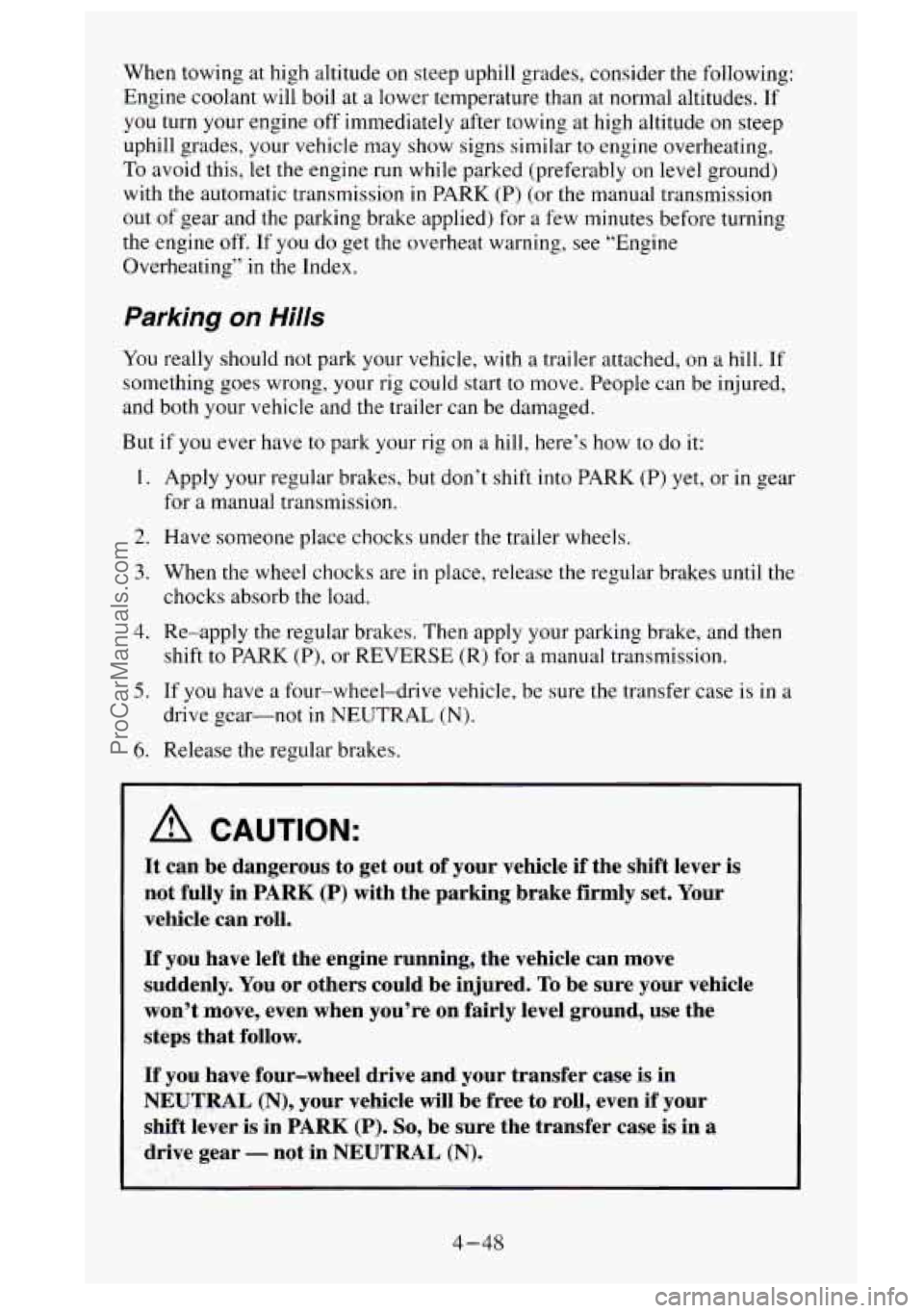
When towing at high altitude on steep uphill grades, consider the following:
Engine coolant will boil at a lower temperature than at normal altitudes. If
you turn your engine off immediately after towing at high altitude on steep
uphill grades, your vehicle
may show signs similar to engine overheating.
To avoid this, let the engine run while parked (preferably on level ground)
with the automatic transmission
in PARK (Pj (or the manual transmission
out
of gear and the parking brake applied) for a few minutes before turning
the engine off.
If you do get the overheat warning, see “Engine
Overheating”
in the Index.
Parking on Hills
You really should not park your vehicle, with a trailer attached, on a hill. If
something goes wrong, your rig could start to move. People can be injured,
and both your vehicle and the trailer can be damaged.
But
if you ever have to park your rig on a hill, here’s how to do it:
1.
2.
3.
4.
5.
6.
Apply your regular brakes, but don’t shift into PARK (P) yet, or in gear
for a manual transmission.
Have someone place chocks under the trailer wheels.
When the wheel chocks are
in place, release the regular brakes until the
chocks absorb the load.
Re-apply the regular brakes. Then apply your parking brake, and then
shift
to PARK (P), or REVERSE (Rj for a manual transmission.
If you have
a four-wheel-drive vehicle, be sure the transfer case is in a
drive gear-not in NEUTRAL
(N).
Release the regular brakes.
A CAUTION:
It can be dangerous to get out of your vehicle if the shift lever is
not fully in
PARK (P) with the parking brake firmly set. Your
vehicle can rofl.
If you have Ieft the engine running, the vehicle can move
suddenly. You or others could be injured.
To be sure your vehicle
won’t move, even when you’re on fairly level ground, use the
steps that follow.
If you have four-wheel drive and your transfer case is in
NEUTRAL (N), your vehicle will be free to roll, even if your
shift lever is in
PARK (P). So, be sure the transfer case is in a
drive gear
- not in NEUTRAL (N).
4-48
ProCarManuals.com
Page 234 of 488
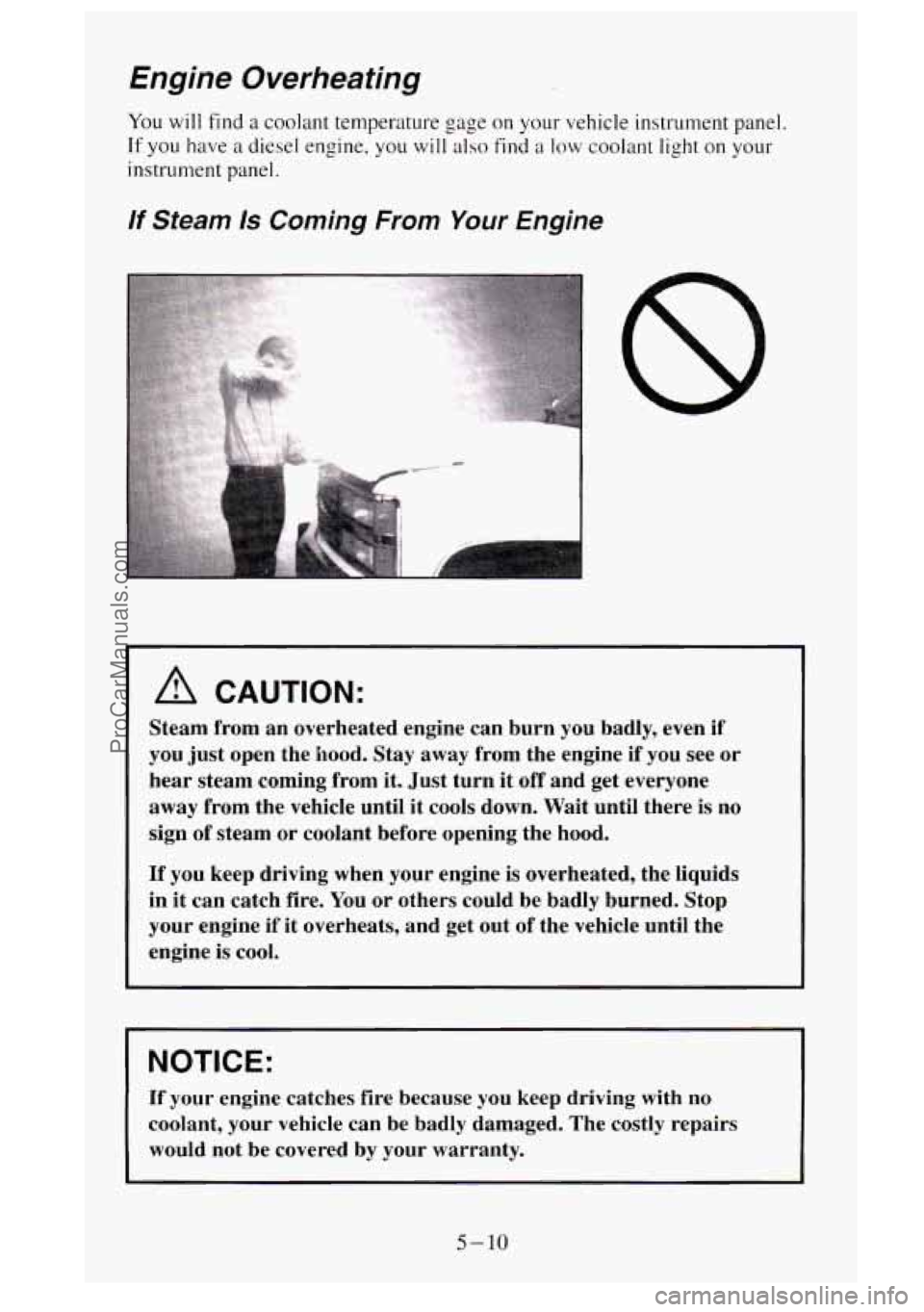
Engine Overheating
YOU will find a coolant temperature gage on your vehicle instrument panel.
If
YOU have a diesel engine, you will also find a low coolant light on your
instrument panel.
lf Steam Is Coming From Your Engine
A CAUTION:
Steam from an overheated engine can burn you badly, even if
you just open the hood. Stay away from the engine if you see or
hear steam coming from it. Just turn it
off and get everyone
away from the vehicle until it cools down. Wait until there is no
sign of steam or coolant before opening the hood.
If you keep driving when your engine is overheated, the liquids
in it can catch fire. You or others could be badly burned. Stop
your engine
if it overheats, and get out of the vehicle until the
engine
is cool.
NOTICE:
If your engine catches fire because you keep driving with no
coolant, your vehicle can be badly damaged. The costly repairs
would not be covered by your warranty.
5-10
ProCarManuals.com
Page 235 of 488
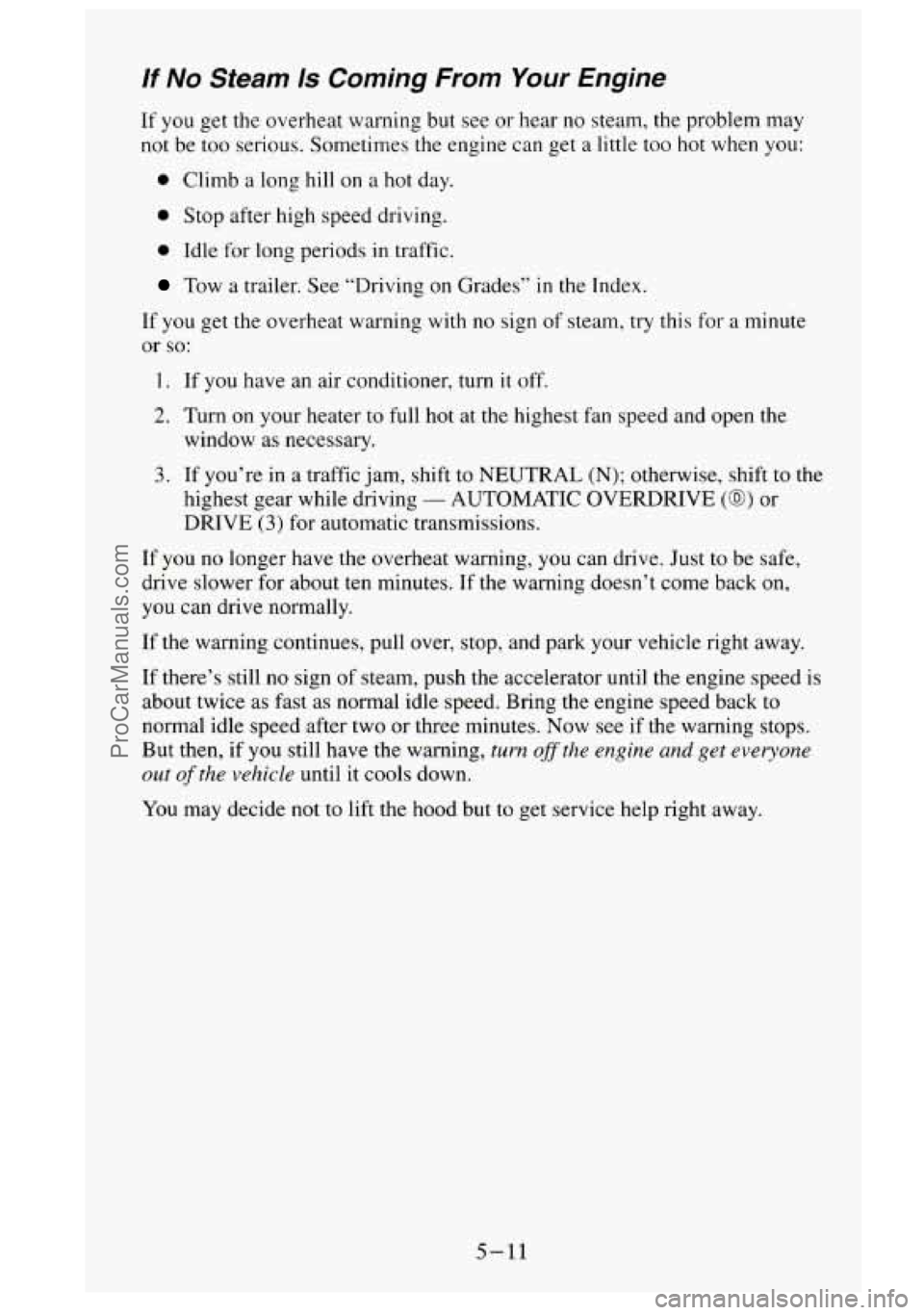
If No Steam Is Coming From Your Engine
If you get the overheat warning but see or hear no steam, the problem may
not be too serious. Sometimes the engine can get a little too hot when you:
0 Climb a long hill on a hot day.
0 Stop after high speed driving.
0 Idle for long periods in traffic.
Tow a trailer. See “Driving on Grades’’ in the Index.
If
you get the overheat warning with no sign of steam, try this for a minute
or
so:
1. If you have an air conditioner, turn it off.
2. Turn on your heater to full hot at the highest fan speed and open the
window as necessary.
3. If you’re in a traffic jam, shift to NEUTRAL (N); otherwise, shift to the
highest gear while driving
- AUTOMATIC OVERDRIVE (@) or
DRIVE
(3) for automatic transmissions.
If you no longer have the overheat warning, you can drive. Just to be safe,
drive slower for about ten minutes. If the warning doesn’t come back on,
you can drive normally.
If
the warning continues, pull over, stop, and park your vehicle right away.
If there’s still no sign of steam, push the accelerator until the engine speed is
about twice as fast as normal idle speed. Bring the engine speed back to
normal idle speed after two or three minutes. Now see
if the warning stops.
But then, if
you still have the warning, turn ofSthe engine and get everyone
out of the vehicle until it cools down.
You may decide not to lift the hood but to get service help right away.
5-11
ProCarManuals.com